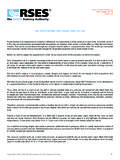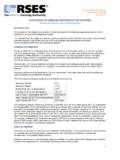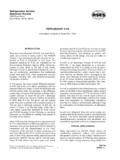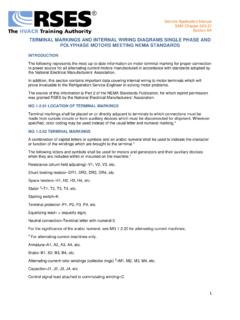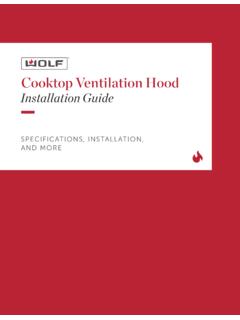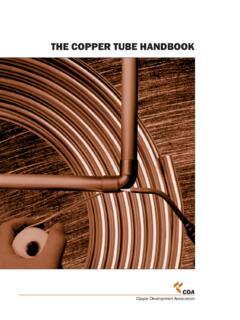Transcription of THE PSYCHROMETRIC CHART AND ITS USE - Society & …
1 Copyright 1959, 2009, By refrigeration Service Engineers Application ManualSAM Chapter 630-16 Section 3 ATHE PSYCHROMETRIC CHART AND ITS USEP sychrometry is an impressive word which is defined as the measurement of the moisture content of air. In broader terms it is the science and practices associated with atmospheric air mixtures, their control, and the effect on materials and human comfort. This can be accomplished through use of PSYCHROMETRIC tables or a PSYCHROMETRIC CHART . The tables are somewhat more accurate, but the CHART is accurate enough for all practical purposes and is much easier to we start to explain the PSYCHROMETRIC CHART , let us review a few of the principles on which it is , atmospheric air is a mixture consisting of dry air and water vapor in varying relative amounts.
2 It is best to think of dry air and water vapor separately, for they behave independently of one another. In this chapter, when dry air is referred to, it will mean the air part; when water vapor or moisture is referred to, it will mean the water part; and when referring to just air, it will mean the mixture of dry air and water air is itself a mixture of several gases, mainly nitrogen and oxygen, but these do not change in their proportions, and they behave so much the same, that we can consider dry air as if it were a single know dry air only as a gas. It can be liquefied, but at very low temperatures, about 300 F below zero. In our atmosphere it is superheated three or four hundred degrees, or far above its condensing or boiling , when we warm or cool dry air, we add or remove sensible heat only, and are not concerned with latent heat.
3 Dry air obeys the gas laws of Charles, and Boyle, which state that if a gas, such as air, is heated, it expands and its density or weight per cubic foot becomes less, provided the pressure remains constant. Conversely, if we cool dry air, it becomes heavier per cubic foot, again provided that its pressure remains constant. Moreover, the temperatures, densities, volumes, and pressures all vary , problems connected with cooling or heating dry air are rather simple, for when we cool it we remove its sensible heat of about 1/4 of a Btu per pound of dry air per degree, and when we heat dry air, we add that same amount of sensible a room at normal temperatures. It is filled with a mixture of dry air and water vapor. Each fill the room, so their volumes are equal.
4 However, their densities are far different because the water vapor is a very light gas. At ordinary room temperatures, it constitutes only about 1/2 to 1 1/2 per cent of the total weight of the mixture which we call , in addition to having weight, also exerts a pressure, called barometric pressure, which is usually measured in inches of mercury above a perfect vacuum. Standard barometric pressure at sea level is inches of mercury, which is equivalent to pounds per square inch pressure exerted by the air, or barometric pressure, is caused by both the dry air and the water vapor. Most of the total pressure is from the air, but some is from the water vapor. As is true of the weight, or density, the pressure from the water vapor is usually only about 1/2 to 1 1/2 per cent of the total 1959, 2009, By refrigeration Service Engineers is essential to always keep in mind that air consists of two separate gases, dry air and water vapor, which act independently, each according to its individual properties, just as if the other were not there.
5 The total density of air is the sum of the densities of the dry air and water vapor; and the total pressure is the sum of the partial pressure of the dry air and the partial pressure of the water the water vapor is a very small part of air, as far as density and pressure are concerned, it is the part which complicates the PSYCHROMETRIC processes and calculations. For example, the amount of water vapor in the air varies widely from time to time according to temperature, and the proportion of water vapor in the air must be regulated in order to provide comfortable would not be necessary to regulate the amount of water vapor in the air if it remained as a superheated gas, and providing comfortable conditions would not be difficult, for we would only have to control the dry bulb temperature of the air.
6 It s not that simple, however, because at the temperatures at which we normally work, the water vapor sometimes condenses into water. When this occurs, a large amount of latent heat must be removed, and as you know, the latent heat per pound of water is extremely large compared to the sensible heat. Consequently, when water vapor is condensed out of the air, a large amount of cooling capacity is cooling air, such as in summer air conditioning, we are chiefly concerned with:Cooling the dry air, which is comparatively simple and involves sensible cooling only. (The water vapor is such a 1. small part of the air that we usually ignore its sensible heat.)Controlling the amount of water vapor in the air. This involves condensing out some of the water vapor, thus bringing 2.
7 Its large latent heat into the and distributing the air, which involves changes in density and Mixing together air from two different sources, at different temperatures, and different percents of water These four processes, along with others, involved in the controlling of atmospheric conditions for human comfort, are commonly referred to as PSYCHROMETRIC processes. In order to arrive at the proper amounts of humidification or dehumidification and heating or cooling necessary to effect these changes, we make use of the PSYCHROMETRIC tables or USE OF THE PSYCHROMETRIC TABLEThe PSYCHROMETRIC properties in Table 54T03 have been compiled through countless laboratory experiments and mathematical calculations and are the basis for what we know as the PSYCHROMETRIC 1959, 2009, By refrigeration Service Engineers 54T03 Thermodynamic Properties of Air based on one pound of air at a total pressure of (Atmospheric pressure)Copyright 1959, 2009, By refrigeration Service Engineers 54T03 (cont)
8 Thermodynamic Properties of Air based on one pound of air at a total pressure of (Atmospheric pressure)Copyright 1959, 2009, By refrigeration Service Engineers 54T03 (cont) Thermodynamic Properties of Air based on one pound of air at a total pressure of (Atmospheric pressure)This table, and in fact the whole PSYCHROMETRIC CHART , is based on standard atmospheric pressure, also called barometric pressure, of inches of mercury. This is the total pressure of the mixture of dry air and water vapor, each of which has its own partial pressure, and these pressures must be added together to get the total pressure. If we were to add water vapor to a cubic foot of dry air at standard atmospheric pressure, the total pressure would then be greater than inches of mercury.
9 To balance this and keep the same total pressure of inches of mercury, we would have to let a little air out before we add the water water vapor is very light compared to air, if we let the heavier air out and replace it with the lighter water vapor, the density of the mixture will be less than that of the dry air alone. If we look at the density of air at 60 F on Table 54T03, we find that its density at saturation is .0750 lbs/cu ft, while the density of dry air at 60 F is .0763 lbs/cu ft, or .0013 lbs more than the saturated PRESSUREW ater, like any other liquid such as ammonia, sulfur dioxide, or other refrigerants, has different boiling points at different pressures. These pressures are very low, however, compared to most refrigerants.
10 Table 54T06 shows the pressure-temperature relationship for water. The pressures are in inches of mercury absolute (not vacuum) and the temperatures are in degrees 1959, 2009, By refrigeration Service Engineers 54T06 Saturated Water VaporCopyright 1959, 2009, By refrigeration Service Engineers 54T06 (Cont.) Saturated Water VaporThe water vapor in ordinary air is very light and has a very low pressure. If we start to cool the mixture, the water vapor gets denser (specific volume decreases) until it finally gets down to the temperature at which moisture starts to condense out of the air. The temperature at which this happens is called the dew point. We could also call this the condensing temperature or the boiling temperature, for it is the temperature at which water vapor condenses or water evaporates at its corresponding is commonly called the saturation pressure or condensing pressure with refrigerants is called vapor pressure when referring to water vapor.
